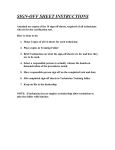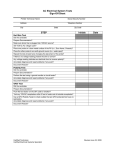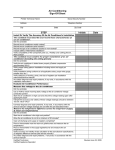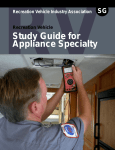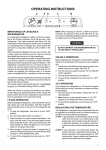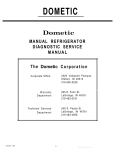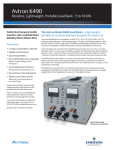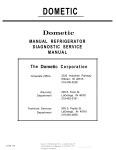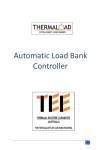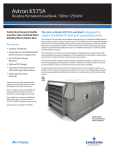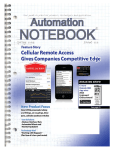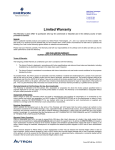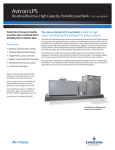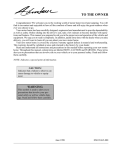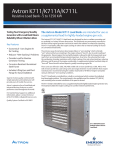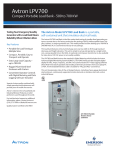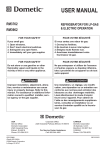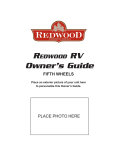Download SIGN-OFF SHEET INSTRUCTIONS
Transcript
SIGN-OFF SHEET INSTRUCTIONS Attached are copies of the 14 sign-off sheets, required of all technicians who plan to test for certification. Here is what to do: 1. Make Copies of all 14 sheets for each technician. 2. Place copies in Training Folder 3. Brief Technicians on what the sign-off sheets are for and how they are to be used. 4. Select a responsible person to actually witness the hands-on demonstration of the procedures noted. 5. Have responsible person sign off on the completed task and date. 6. File completed sign-off sheets in Technician Training folder 7. Keep on file at the dealership. NOTE: If technician leaves employ at dealership allow technician to take the folder with him/her. Time Propane Pressure Drop Test Sign-Off Sheet Printed Technician Name Social Security Number Address Telephone Number City State Time Pressure Drop Test Conducted at the Range STEP Zip Code Initials Date Did the Candidate: Prepare document (work order, PDI form, etc.) to record time pressure drop test results? Ensure the temperature of both air and piping was approximately the same? Ensure a uniform temperature was maintained throughout the test procedure? Ensure the propane system is turned off at the service valve? Turn off the burner valves on the range and gas valves on other appliances? Turn off all open pilot lights? Turn propane system on at the service valve? Listen to the regulator for sounds of escaping propane that would indicate an open line? Silence indicates the regulator has locked up. Remove a range burner and attach a manometer to the range burner spud? Turn on the burner valve with the manometer and ensure the propane system is pressurized to 10-14” W.C? Turn off propane system at the service valve? Slowly open a second range burner and reduce the operating pressure to a nominal 8” W.C. Turn range burner off after achieving a nominal 8” W.C.? Monitor the manometer for a minimum of 3 minutes? Locate and repair any leak(s) and retest until a successful test is accomplished? (Go to Leak Test Signoff Sheet) Turn off the range burner with the manometer, disconnect the manometer from the range burner spud, and reconnect the range burner? Return propane system to proper operation? Document test results on appropriate documentation. Indicate pressure, time, duration of test, date, and sign? OR Time Pressure Drop Test Using a Propane System Test Kit The following procedures should be used to connect the Propane System Test Kit. These procedures are provided as guidance but are not included in the procedures to be followed in conducting the Time Pressure Drop Test. With all appliances turned off and the propane supply turned off, disconnect the low-pressure hose or piping from the regulator. Connect the 3/8” female flare of the Test Kit flex hose to the regulator outlet fitting. Attach the low-pressure hose, previously attached to the regulator, to the half-union end of the Test Kit. Attach the manometer hose to the 5/16” hose barb on the Test Kit. Make sure the gas cock on the Test Kit is closed. Slowly turn the propane supply back on at the service valve. Conduct a leak test to ensure all connections are leak free. Registered Technician Revised June 23, 2008 STEP Initials Date Did the Candidate: Prepare documentation (work order, PDI form, etc) to record the Time Pressure Drop Test results? Ensure the temperature of both air and piping was approximately the same? Ensure a uniform temperature was maintained throughout the test procedure? Ensure the propane system is turned off at the service valve? Ensure all appliances are turned off? Ensure all open pilot lights are turned off? Turn propane system on slowly at the service valve to bring pressure to between 7.5 and 8.5 “W.C.”? Turn propane off at the service valve? Monitor the manometer for a period of three minutes? Locate and repair leak(s) and retest until a successful test (no pressure drop) is accomplished? (See Leak Test sign-off sheet) Bleed the propane pressure from the system using the gas cock on the Test Kit? Remove the Test Kit from the system and reattach the low-pressure hose or piping? Turn propane system on at the service valve? Leak test the low-pressure hose or piping connection? Document test results on appropriate documentation indicating observed pressure, time, duration of the test, date and sign? Registered Technician Revised June 23, 2008 System Operating Pressure Test, Leak Test, Regulator Adjustment & Lock Up Tests Sign-Off Sheet Printed Technician Name Social Security Number Address Telephone Number City State STEP Zip Code Initials Date System Operating Pressure Test The following procedures apply using test apparatus shown in figure 3-10, page 3-10 of the RVIA Propane Systems Textbook. Did the candidate Prepare document (work order, PDI form, etc.) to record test results? Ensure the propane system is turned off at the container service valve? Turn off all appliances? Disconnect the propane low pressure hose from the regulator (use backup wrench)? Connect test apparatus to the regulator? Connect the Propane low pressure hose to the test apparatus? Install manometer to the apparatus? Open service valve on the container? Open gas cock on test apparatus (simulates 50 % flow)? Measure inches of water column WC on manometer 10.5-11.5 WC? Adjust regulator if measured WC is incorrect? Document test results? Propane Regulator Adjustment If Propane pressure is greater than 11.5" WC Did the candidate Prepare documentation? Remove dust cap? Adjust by turning the adjustment screw counter clockwise until proper pressure is achieved? Reinstall dust cap? Document results? If Propane pressure is less than 10.5" WC Did the candidate Remove dust cap? Adjust by turning the adjustment screw clockwise until proper pressure is achieved? Reinstall dust cap? Document results? Propane Regulator Lockup Test Upon completion of the Operating Pressure Test and Regulator Adjustment Did the candidate Close the cock on apparatus? Monitor propane pressure on manometer for 3 minutes? If pressure exceeds 14" WC replace regulator? Turn off Propane at the service valve at the container? Remove test apparatus? Registered Technician Revised June 23, 2008 STEP Initials Date Reconnect low pressure hose to regulator (use backup wrench)? Conduct a leak test on any fittings that were disconnected? Return system back to proper operation? Document results? Propane Leak Test This test must be preformed any time a propane line is opened or a leak is indicated during a timed pressure test Perform either of the following methods. Using an electronic leak detector Did the candidate Prepare documentation? Open service valve to pressurize propane system? Turn off all appliances? Turn on the electronic leak detector? Test the electronic leak detector using a butane lighter? Operate the electronic leak detector per the manufactures recommendation? Repair or tighten connections using backup wrenches? Document results? Using a non corrosive leak detector solution Did the candidate Open service valve to pressurize propane system? Turn off all appliances? Cover each connection with the solution? Monitor for bubbles if leak is present? Repair or tighten connections using backup wrenches? Document results? Registered Technician Revised June 23, 2008 Measuring AC Voltage, Amperage Resistance and Continuity Sign-Off Sheet Printed Technician Name Social Security Number Address Telephone Number City State STEP Zip Code Initials Date Measuring AC Voltage Did the candidate Set VOM to highest AC voltage scale? Ensure meter capacity is greater than expected voltage? Measure AC voltage at various locations (i.e. AC Receptacles)? Connect black lead to circuit neutral? Connect red lead to the live side of the circuit? Switch VOM down to best range? Read the indicated value? Measuring Amperage (Current) When using an in-line (series) ammeter or VOM Did the candidate Ensure meter capacity is greater than expected amperage? Set VOM to highest AC amps scale? Turn off power to the circuit? Disconnect the circuit at the point where the current is to be measured? Install the VOM leads in series between the source of current and the device being measured? Turn on the power to the device being measured? Switch the VOM scale to the lowest safe range? Read the indicated current? Turn off power to the circuit? Return the circuit to its original condition Accurately diagnose and repair problems if any exist? When using a clamp-on meter Did the candidate Clamp the jaws of the meter around one of the conductors feeding power to a live electrical circuit or device? Read the current draw in amperage? Isolate the component from the circuit Set the ammeter to the proper amp scale Read results on the meter Registered Technician Revised June 23, 2008 STEP Initials Date Checking Continuity Did the candidate Turn off all VAC power? Isolate the component to be checked by disconnecting all the wires? Set the VOM to the Ohms scale? Place one probe on each terminal of the item to be checked? Shorted Circuit (i.e., Two wires touching, or a closed switch). Meter reading will show Zero Ohms (sometimes a meter will read .1 to .3 ohms due to resistance in the meter leads). Open Circuit (i.e., Wire cut in half, or a switch that won’t make continuity). Meter reading will show infinity (i.e., most digital meters will read OL or OFL). Grounded Circuit (i.e., Bare wire touching ground). Meter will read the same way as a short (zero) when the circuit is tested from a conductor to ground> Read the indicated value? Accurately diagnose and repair problems if any exist? Compare the reading to component specifications Registered Technician Revised June 23, 2008 Measuring DC Voltage, Amperage Resistance and Continuity Sign-Off Sheet Printed Technician Name Social Security Number Address Telephone Number City State STEP Zip Code Initials Date Measuring DC Voltage Did the candidate Set VOM to DC voltage scale? Ensure meter capacity is greater than expected voltage? Measure DC voltage at various locations (i.e. brake lights, tail lights)? Connect black lead to circuit ground? Connect red lead to the live side of the circuit? Read the indicated value? Measuring Amperage (Current) If using an in-line (series) ammeter or VOM Did the candidate Set VOM to DC amps scale? Ensure meter capacity is greater than expected amperage? Turn off power to the circuit? Disconnect the circuit at the point where the current is to be measured? Install the VOM leads in series between the source of current and the device being measured? Turn on the power to the device being measured? Read the indicated value? Turn off power to the circuit? Return the circuit to its original condition? Measuring Resistance (Ohms) Did the candidate Turn off electrical power? Isolate the component from the circuit? Set the VOM to the proper Ohms scale? Read results on the meter? Registered Technician Revised June 23, 2008 STEP Initials Date Checking Continuity Did the candidate Turn off all VDC power? Isolate the component to be checked by disconnecting all the wires? Set the VOM to the Ohms scale? Place one probe on each terminal of the item to be checked? Shorted Circuit (i.e., Two wires touching, or a closed switch). Meter reading will show Zero Ohms (sometimes a meter will read .1 to .3 ohms due to resistance in the meter leads) Open Circuit (i.e., Wire cut in half, or a switch that wont make continuity). Meter reading will show infinity (i.e., most digital meters will read OL or OFL) Grounded Circuit (i.e., Bare wire touching ground). Meter will read the same way as a short (zero) when the circuit is tested from a conductor to ground Read the indicated value? Accurately diagnose and repair problems if any exist? Compare the reading to component specifications? Registered Technician Revised June 23, 2008 AC Electrical System Tests Sign-Off Sheet Printed Technician Name Social Security Number Address Telephone Number City State STEP Zip Code Initials Date Hot Skin Test Did the candidate Prepare Documentation? Make sure shore line is plugged into 120VAC source? Set VOM to AC voltage scale? Place one probe on a bare metal surface of the RV (i.e., Door frame, Chassis)? Place the other probe to an earth ground source (i.e., water pipe)? Repeat the test at least twice changing the placement of the probe? If there is no voltage reading present the skin is not hot? Any voltage reading indicates an electrical short or reverse polarity? Accurately diagnose and repair problems if any exist? Document Results? Polarity Test Did the candidate Prepare Documentation? Perform the test using a ground monitor or circuit tester? Accurately diagnose and repair problems if any exist? Document Results? GFCI Test Did the candidate Prepare Documentation? Push the test button on the GFI outlet or breaker? Test any 120VAC receptacles within 5 feet of water and all outside receptacles? Use a GFCI Polarity Tester to check outlets that are GFCI protected but have no test button. Accurately diagnose and repair problems if any exist? Document Results? Certified Technician Certified Electrical Systems Specialist Revised June 23, 2008 Air Conditioning Sign-Off Sheet Printed Technician Name Social Security Number Address Telephone Number City State STEP Zip Code Initials Date Install Or Verify The Accuracy Of An Air Conditioner’s Installation The candidate must describe and record these characteristics of an air conditioner. Did the candidate Record the air conditioner model number? Record the air conditioner serial number? Record the type of air conditioner (ducted or non-ducted)? Indicate OEM or Aftermarket installation? Verify compatibility of the component parts (i.e., Rooftop unit, Ceiling plenum, Wall control)? The candidate must confirm the proper installation of an air conditioner (including the ceiling plenum) Did the candidate Verify the air conditioner is bolted down properly (Gasket compression approximately 50%)? Verify proper ceiling plenum installation including return and supply air separation? Verify installation wiring conforms to all applicable codes, proper wire gauge, breaker size, etc.? Verify adequacy of ducting, vents, and size of registers per installation instructions/service manual? Accurately diagnose and repair problems, if any exist, in accordance with the installation instructions? Evaluate Air Conditioner Performance Measure line voltage to the air conditioner Did the candidate Use a VOM to check incoming static voltage at the air conditioner voltage connection points? Start the air conditioner on high cool and check this voltage reading again after applying the load? Interpret the accuracy and validity of these voltage readings (should be between 103.5 & 126.5 VAC)? Correctly diagnose and repair problems, if any exist, in accordance with the service manual if voltage readings are not within the pre-described limits? Measure the temperature difference across the evaporator (supply & return air temperatures) Did the candidate Start the air conditioner in the high cool position? Allow the air conditioner to run for a minimum of 30 minutes? Open all discharge and supply air registers completely? Place a thermometer near the return air grille/louvers and measure the air temperature? Place a thermometer in the supply register/louver and measure the air temperature? Verify accuracy and validity of this calculation to the manufacturer specifications; 20 degrees difference nominal (See service manual)? Accurately diagnose and repair problems, if any exist, in accordance with the service manual? Certified Technician Certified Appliance Specialist Revised June 23, 2008 STEP Initials Date Measure the compressor amperage Did the candidate Start the air conditioner in the high cool position? Allow the air conditioner to run for a minimum of 30 minutes? Measure the outdoor ambient temperature? Record the compressor rated load amperage (RLA) printed on the air conditioners rating plate? Use the information found in the service manual to calculate correct amperage based on RLA and outdoor temperature? Read the compressor amperage with an Ammeter? Confirm the measure compressor amperage and calculated amperages are approx. equal? Accurately diagnose and repair problems, if any exist, in accordance with the service manual? Subtract the supply air temperature from the return air temperature? Certified Technician Certified Appliance Specialist Revised June 23, 2008 Troubleshooting Air Conditioner Key Electrical Components Sign-Off Sheet Printed Technician Name Social Security Number Address Telephone Number City State STEP Zip Code Initials Date Note: Due to product differences the candidate must consult the service manual for individual component specifications, procedures, and sequence of operation Air Conditioner Compressor Did the candidate Correctly measure compressor amperage? Correctly measure resistance of the compressor motor windings? Remove all electrical power from the air conditioner; remove all wires from the compressor; check terminals C&R, C&S, R&S? Measure running voltage at the proper location on the compressor? Accurately diagnose compressor problems, if any exist, in accordance with the service manual? Air Conditioner Fan Motor Did the candidate Correctly measure fan motor amperage? Correctly measure resistance of the fan motor windings? Remove all electrical power from the air conditioner; remove all wires from the fan motor; check motor windings for short, open or ground (see service manual)? Measure running voltage at the proper location on the fan motor? Accurately diagnose and repair fan motor problems, if any exist, in accordance with the service manual? Air Conditioner Capacitor(s) Did the candidate Properly discharge the capacitor(s) per the service manual? Properly test the capacitor(s) per the service manual? Accurately diagnose and repair capacitor problems, if any exist, in accordance with the service manual? Select either manual thermostat or wall thermostat Manual Thermostat Did the candidate Remove all electrical power from the air conditioner; remove all wires from the thermostat; check the thermostat with an Ohmmeter? Accurately diagnose and repair the thermostat problems, if any exist, in accordance with the service manual? Manual Selector Switch Did the candidate Remove electrical power from the air conditioner; remove wires from the switch; check the selector switch with an Ohmmeter? Wall Thermostat Did the candidate Measure low voltage power into the wall thermostat? Measure low voltage power out of the wall thermostat? Accurately diagnose and repair thermostat problems, if any exist, in accordance with the service manual? Certified Technician Certified Appliance Specialist Revised June 23, 2008 STEP Initials Date Upper Control Box Assembly Did the candidate Measure low voltage power from the wall thermostat to the control box? Measure high voltage power (120VAC) out of the upper control box assembly to the rooftop air conditioner? Accurately diagnose and repair control box assembly problems, if any exist, in accordance with the service manual? Accurately diagnose and repair selector switch problems, if any exist, in accordance with the service manual? Certified Technician Certified Appliance Specialist Revised June 23, 2008 Batteries, Inverters and Converters Sign-Off Sheet Printed Technician Name Social Security Number Address Telephone Number City State STEP Zip Code Initials Date Draw a Diagram of Batteries in a Parallel Circuit Draw a Diagram of Batteries in a Series Circuit Perform a Battery Load Test Did the candidate Wear appropriate protective clothing? Disconnect batteries from coach? Hookup battery load tester according manufacturer specifications? Perform Battery Maintenance Did the candidate Wear appropriate protective clothing? Clean terminals? Clean cable clamps? Clean battery tops? Check and add battery fluid level on non-maintenance free batteries? Check Inverter Did the candidate Remove shore power and shut off generator? Check battery? It should be fully charged. If it is not, charge battery Turn the inverter on? Measure DC voltage input at the inverter? Nominal voltage should be 12 VDC Measure AC voltage output at the inverter? Nominal voltage should be 120 VAC Accurately diagnose and repair problems if any exist? Check Converter Did the candidate Measure AC voltage into the converter? Nominal voltage should be 90-135 VAC or 120 VAC with a RMS meter. Measure DC voltage output? Loaded and unloaded. Nominal voltage should be within manufacturer’s specifications. Test the converter’s battery charger at the converter? Turn off all 12 volt loads? Disconnect battery cable at the converter? Set the VOM on VDC scale? Connect positive probe to the converter charge lug? Connect the negative probe to converter ground lug? Measure voltage. If voltage is less than 13 VDC or more than 14.2 VDC a problem may exist? Accurately diagnose and repair problems if any exist? Certified Technician Certified Electrical Systems Specialist Revised June 23, 2008 Furnace Sign-Off Sheet Printed Technician Name Social Security Number Address Telephone Number City State Zip Code STEP Initials Date Install or Verify the Accuracy of a Furnace’s Installation The candidate must describe and record these characteristics of a furnace. Did the candidate Record the furnace model number? Record the furnace serial number? Record the type of furnace system? Indicate OEM or Aftermarket installation? The candidate must confirm the proper installation of a furnace. Did the candidate Verify proper ducting? Verify proper return air? Verify proper gas pressure at furnace? Verify proper propane connections and conduct a leak test ? Document leak test results? Verify proper DC/AC voltage at furnace? Verify proper exhaust vent system? Verify proper seals at door, vents etc.? Accurately diagnose and repair installation problems, if any exist, in accordance with the installation manual? Evaluate Furnace Performance Measure line voltage at the furnace Did the candidate Check incoming voltage at the wire connections on side of furnace? Nominal voltage should be 10.5-13.5 VDC under unloaded condition. Turn furnace on? Verify ignition? Check voltage at the wire connections on side of furnace? Nominal voltage should be 10.5-13.5 VDC under loaded condition. Accurately diagnose and repair problems, if any exist, in accordance with the service manual? Measure propane pressure at furnace Did the candidate Turn propane off at container? Install manometer at pressure test port? Turn propane on at container? Check for proper gas pressure (see service manual)? Document measurement results? Accurately diagnose and repair problems, if any exist, in accordance with the service manual? Certified Technician Certified Appliance Specialist Revised June 23, 2008 STEP Initials Date Evaluate proper air flow Did the candidate Open all discharge registers and any closeable registers(see installation and or service manual for requirements)? Verify air discharge by feel or using an air speed indicator? Verify that the discharge is warm? Accurately diagnose and repair problems, if any exist, in accordance with the service manual? Evaluate return air flow Did the candidate Verify proper return air opening size (see installation and or installation manual)? Accurately diagnose and repair problems, if any exist, in accordance with the service manual? Certified Technician Certified Appliance Specialist Revised June 23, 2008 Troubleshooting Key Furnace Electrical Components Sign-Off Sheet Printed Technician Name Social Security Number Address Telephone Number City State STEP Zip Code Initials Date Troubleshoot Key Furnace Electrical Components Did the candidate verify sequence of operation per the service manual to evaluate the following components? Thermostat Did the candidate Verify proper height and location per installation and or service manual? Verify voltage to thermostat and voltage out of thermostat to furnace (see service manual)? On/Off Switch Did the candidate Remove power wires and check switch for continuity using an ohmmeter? Accurately diagnose and repair problems, if any exist, in accordance with the service manual? Circuit Breaker (If applicable) Did the candidate Measure DC voltage in and out of circuit breaker? Accurately diagnose and repair problems, if any exist, in accordance with the service manual? Time Delay Relay (if applicable) Did the candidate Confirm DC voltage at proper terminals (refer to service manual)? Accurately diagnose and repair problems, if any exist, in accordance with the service manual? Blower Motor Did the candidate Confirm DC voltage to blower motor? Measure DC amperage at motor (see service manual)? Accurately diagnose and repair problems, if any exist, in accordance with the service manual? Limit Switch Did the candidate Verify continuity or DC voltage through limit switch? Accurately diagnose and repair problems, if any exist, in accordance with the service manual? Sail Switch Did the candidate Verify continuity or DC voltage through sail switch? Accurately diagnose and repair problems, if any exist, in accordance with the service manual? Certified Technician Certified Appliance Specialist Revised June 23, 2008 STEP Initials Date Either Fan Control Circuit Board Verify proper DC voltage to circuit board (see manual)? Verify function of circuit board (see manual functions)? Spark DC voltage to gas valve Sense flame Energize relay to start fan Accurately diagnose and repair problems, if any exist, in accordance with the service manual? Or Ignition Board Did the candidate Verify proper DC voltage to ignition board (see manual)? Verify function of ignition board (see manual functions)? Spark DC voltage to gas valve Sense flame Accurately diagnose and repair problems, if any exist, in accordance with the service manual? Gas Valve Did the candidate Measure proper voltage at valve? Remove power wires and check coils for proper resistance 30-50 ohms? Check for proper gas flow exiting valve orphic (if ignition fails check by smell or use manometer)? Accurately diagnose and repair problems, if any exist, in accordance with the service manual? Electrode Did the candidate Check for proper gap (see manual)? Check for proper spark across electrode to ground? Accurately diagnose and repair problems, if any exist, in accordance with the service manual? Did the candidate Certified Technician Certified Appliance Specialist Revised June 23, 2008 Generator Sign-Off Sheet Printed Technician Name Social Security Number Address Telephone Number City State STEP Zip Code Initials Date Install or Verify the Accuracy of a Generator’s Installation The candidate must describe and record these characteristics of a generator set Did the candidate Record the generator’s make? Record the generator’s model number? Record the generator’s Serial number? Determine the generator’s kilowatt (kW) rating? Determine the generator’s maximum amperage output? Identify the generator’s fuel type? The candidate must confirm the proper installation of a generator Did the candidate Verify generator mounting is level and will support the weight of the generator set? Verify the proper generator top, side, back and front clearances per the installation manual? Verify the generator compartment is sealed from the coach interior? Verify all AC and DC connections and routings comply with NEC codes? Verify fuel line and routings and fuel tank pickup comply with all applicable codes? Verify cooling air inlet and cooling air discharge is sized correctly per installation manual? Verify the engine exhaust pipes are properly installed per installation manual and comply with all applicable codes? Accurately diagnose and repair any installation problems in accordance with the installation instructions? Evaluate Generator Performance Measure AC output voltage at no-load Did the Candidate Use a voltmeter set on the AC scale to check output voltage at the junction box? Verify the voltage reading is correct per the service manual? Accurately diagnose and repair problems, if any exist, in accordance with the service manual? Measure AC output voltage at full rated load Did the Candidate Use a voltmeter set on the AC scale to check output voltage at the junction box? Use loadbank to properly apply maximum rated load on generator set per service manual? Indicate if loadbank is available. Verify the voltage reading is correct per the service manual? Accurately diagnose and repair problems, if any exist, in accordance with the service manual? Measure proper AC voltage frequency (engine RPM) at no-load Did the Candidate Certified Technician Certified Electrical Systems Specialist Revised June 23, 2008 STEP Initials Date Use a frequency meter to check output voltage frequency at the junction box? Verify the frequency reading is correct per the service manual? Accurately diagnose and repair problems, if any exist, in accordance with the service manual? Measure proper AC voltage frequency (engine RPM) at full load Did the Candidate Use a frequency meter to check output voltage frequency at the junction box? Use loadbank to properly apply max rated load on generator set per service manual? Indicate if loadbank is available. Verify the frequency reading is correct per the service manual? Accurately diagnose and repair problems, if any exist, in accordance with the service manual? Troubleshoot Key Generator Components by Sequence of Operation Start Solenoid Did the candidate measure DC voltage at the proper terminal per the service manual? Starter Motor Did the candidate measure DC voltage at the proper terminals per the service manual? Ignition System Did the candidate Use a spark tester to check if ignition is present? Visually inspect spark plug and reset plug to proper gap? Use ohmmeter to measure resistance of the primary and secondary winding of the ignition coil? Fuel System Did the candidate Verify fuel tank level is greater than 1/4? Use voltmeter set on the DC scale, measure voltage to the fuel pump per the service manual? Measure fuel pressure between the fuel pump and carburetor? Use voltmeter set on the DC scale, measure voltage to the fuel solenoid per the service manual? Generator System Did the candidate Measure field flash voltage using a voltmeter set on the DC scale. Measure voltage per the service manual? Check resistance of the rotor using an ohmmeter per the service manual? Accurately diagnose and repair problems, if any exist, in accordance with the service manual? Certified Technician Certified Electrical Systems Specialist Revised June 23, 2008 Water Heater Sign-Off Sheet Printed Technician Name Social Security Number Address Telephone Number City State STEP Zip Code Initials Date Install or Verify The Accuracy of a Water Heater’s Installation The candidate must describe and record these characteristics of a water heater. Did the candidate Record the water heater model number? Record the water heater serial number? Verify type of control system? The candidate must confirm the proper installation of a unit Did the candidate Check the seal around the flange? Confirm the vent is clear and properly gapped from door screen (0 to 1/4" - see installation manual)? Confirm the gas line is properly sealed from interior of coach? Verify wiring complies with NEC code (if applicable)? Conduct a leak test on the propane connection to the water heater? Verify the water heater is properly supported? Accurately diagnose and repair problems, if any exist, in accordance with the installation instructions? Evaluate Water Heater Performance Measure propane pressure at water heater Did the candidate Turn propane off at the container? Install manometer on the provided pressure test port? Turn propane on at the container? Check for proper propane pressure (see service manual)? Document results? Accurately diagnose and repair problems, if any exist, in accordance with the service manual? Verify customer complaint Did the candidate Visually inspect gas flame, burner tube, flu box, and wires? Troubleshoot Key Components Determine the proper pilot control type ( pilot, DSI or electric) Pilot Control Gas valve/ECO Did the candidate remove the thermocouple and measure for continuity? Pilot assembly Did the candidate check the pilot for proper flame (see service manual)? Thermocouple Did the candidate measure millivolts in heated state (12 millivolts)? Burner Did the candidate check for blockage at the orifice? Certified Technician Certified Appliance Specialist Revised June 23, 2008 STEP Initials Date DSI Control Switch Did the candidate Determine proper 12 VDC and ground to switch? Verify proper wiring (refer to service manual)? Thermostat Did the candidate test for voltage to thermostat or ECO? Circuit Board Did the candidate check for power to the circuit board from thermostat/ECO? Gas Valve Did the candidate Check for power coming from board/ECO? Disconnect power source and measure ohms on coils on valve (refer to service manual)? Electrode Did the candidate Check for proper gap (refer to service manual)? Check for spark at proper point on electrode? Visually inspect the electrode wire? Burner Did the candidate Inspect burner for proper flame and adjust as necessary (see service manual)? Accurately diagnose and repair problems, if any exist, in accordance with the service manual? Electric Control Switch Did the candidate test for proper voltage to switch? ECO Did the candidate test for power from switch? Thermostat Did the candidate test for power from ECO? Heating Element Did the candidate Test for power from thermostat? Did the candidate disconnect power to heating element and perform an ohms test (see service manual) Accurately diagnose and repair problems, if any exist, in accordance with the service manual? Certified Technician Certified Appliance Specialist Revised June 23, 2008 Refrigerator Sign-Off Sheet Printed Technician Name Social Security Number Address Telephone Number City State STEP Zip Code Initials Date Install or Verify the Accuracy of a Refrigerator’s Installation The candidate must describe and record these characteristics of a refrigerator Did the candidate Record the refrigerator model number? Record the refrigerator serial number? Verify the refrigerator’s type of control system? The candidate must confirm the proper installation of a refrigerator Did the candidate Confirm proper side, top, and rear clearances ? Confirm proper venting per service or installation manual (i.e., bottom, upper, side, or roof vent)? Confirm the refrigerator compartment is properly sealed from interior of coach (see service or installation manual)? Verify wiring complies to NEC code? Verify proper propane connection to refrigerator (leak test)? Accurately diagnose and repair installation problems, if any exist, in accordance with the installation instructions? Evaluate Refrigerator Performance Measure propane pressure at refrigerator Did the candidate Turn the propane off at the container? Install a manometer at the provided pressure test port? Turn propane back on at the container? Measure for proper propane pressure (see service manual)? Accurately diagnose and repair problems, if any exist, in accordance with the service manual? Measure incoming 12 VDC at refrigerator Did the candidate Measure incoming VDC at refrigerator DC terminal block (10.5-14.5 VDC per manufacturer’s specification)? Accurately diagnose and repair problems, if any exist, in accordance with the service manual? Measure 120 VAC at refrigerator Did the candidate Measure incoming VAC (108-132 VAC per manufacturer’s specification) at the receptacle? Measure AC voltage at control board or selector switch? Verify the adequacy of the voltage readings? Accurately diagnose and repair problems, if any exist, in accordance with the service manual? Perform run test (12-24 hrs) Certified Technician Certified Appliance Specialist Revised June 23, 2008 STEP Initials Date Did the candidate Put a thermometer in 1 gallon of water and run the refrigerator for 12-24 hours o o (thermometer should read 40-43 F (4 – 6 C) or less)? Accurately diagnose and repair problems, if any exist, in accordance with the service manual? Certified Technician Certified Appliance Specialist Revised June 23, 2008 Refrigerator Troubleshooting Key Components Sign-Off Sheet Printed Technician Name Social Security Number Address Telephone Number City State STEP Zip Code Initials Date Troubleshoot Electrical Components Manual Control Refrigerator Selector Switch Did the candidate Turn off all AC power to the refrigerator? Disconnect wiring to the selector switch? Perform a continuity test on the selector switch per service manual? Accurately diagnose and repair problems, if any exist, in accordance with the service manual? Thermostat Did the candidate Turn off all AC power to the refrigerator? Disconnect wiring to the thermostat? Perform a continuity test on the thermostat in accordance with the service manual? Accurately diagnose and repair problems, if any exist, in accordance with the service manual? Heating Element (120 VAC/12 VDC) Did the candidate Turn off all AC and DC power to the refrigerator? Disconnect heating element wires? Conduct a resistance test to check for proper resistance per service manual or calculate proper resistance per ohm's law? Accurately diagnose and repair problems, if any exist, in accordance with the service manual? Electronic Control Refrigerator verify model and type of electronic control system Note: Due to the complexity of control systems see the individual service manual to diagnose the following components Upper Control Board Did the candidate check the upper control board (power in and power out)? Lower Control Board Did the candidate check the lower control board (power in and power to appropriate components)? Heating Element (120 VAC/12 VDC) Did the candidate Turn off all AC and DC power to the refrigerator? Disconnect all heating element wires? Conduct a resistance test to check for proper resistance per service manual or calculate proper resistance per ohm's law? Accurately diagnose and repair problems, if any exist, in accordance with the service manual? Certified Technician Certified Appliance Specialist Revised June 23, 2008 STEP Initials Date Propane Components Either Manual Control Refrigerator Safety Valve Did the candidate check the safety valve by testing it using a known good thermocouple? Piezo Igniter Did the candidate depress the Piezo igniter and check for resistance and spark? Thermocouple Did the candidate check the thermocouple using a known good safety valve or by measuring for millivolts (13-20 millivolts) in accordance with the service manual? Electrode Did the candidate visually inspect for cracks in wiring or the ceramic insulator? Or Electronic Control Refrigerator Gas Valve Did the candidate Disconnect wires to the gas valve and measure ohm's resistance (see service manual)? Verify propane pressure through the gas valve with a manometer installed at the test port and with the gas valve energized? Reigniter Did the candidate Measure 12 VDC at the reigniter (Minimum 9.5 VDC - see service manual)? Check ground to the reigniter? Electrode Did the candidate Check for cracks in wiring and ceramic covering? Verify the electrode has the proper spark gap (see service manual)? Thermocouple Did the candidate measure millivolts with refrigerator operating on propane (see service manual for specific readings)? Orifice Did the candidate verify proper orifice size (see service manual)? Did the candidate accurately diagnose and repair problems, if any exist, in accordance with the service manual? Certified Technician Certified Appliance Specialist Revised June 23, 2008



























